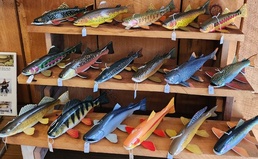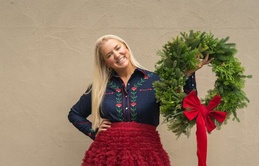
Black Cats Aren’t Bad Luck (and Other Pet Myths)
Two local rescues share the myths and realities of rescue work
By Maxwell Howard | Oct. 26, 2024
When Northern Express sat down with Melissa Smith, vice president of TC Paw Cat Rescue, she was watching a live feed of a trail cam intently. On the screen was a live trap.
“There are humane traps,” Smith says. “No one’s getting hurt. I simply set up a little trail of food, and the kitty walks all the way in. It steps on something, and it closes the door with the cat inside.”
The trapping site is just 10 minutes from her home, and Smith has it set for lost cats that have been reported in the area. In fact, she’s on standby for a few different traps. “Never a dull moment,” jokes Smith.
TC Paw was founded just over a year and a half ago after another shelter in Antrim County, AC Paw, announced it would retire its animal rescue operations to shift its focus to other services. As with many new organizations, the founders have to wear a number of different hats. Smith’s job consists mostly of handling media relations for TC Paw, but she’s also picked up some other responsibilities along the way.
“I do all of the tracking when it comes to cats that are outside,” says Smith. “I do a lot of missing cat search and rescue.”
Smith says what she’s seen on the trail cams in the last year and a half has been eye opening. Lots of times when she is looking for one cat, she encounters many more cats she had never been called to rescue.
“When I encounter other cats, I’m thinking—wait a minute, who does this cat belong to? I can’t tell you how many dozens upon dozens of cats I will get on my cameras at night.”

Pepsi and Coca-Cola are available for adoption through the Cherryland Humane Society.
Pets Aren’t Cheap
Smith says one of the big drivers she is seeing so many cats out in the wild is simply due to cost of care. The majority of cats who’ve been lost or let go seem to be a result of financial difficulties.
LendingTree.com released a survey last month which showed that, among nearly 2,000 U.S. consumers, 12 percent of Americans (and 25 percent of Gen Zers) have surrendered a pet because they could no longer afford to care for it. On top of that, 85 percent of pet owners say inflation is making ownership more expensive, with 41 percent struggling to afford costs.
“I think what we’re seeing on our end with TC Paw,” says Smith, “is that people are facing a financial crisis. They’re losing their home or they can’t get into a home where they can bring pets.”
In the past five years, the trend for cat adoptions has stayed steady while adoption rates for dogs—especially larger ones—has declined. This is most likely due to the extra expenses that come with a large pet. Tia Barbera, an animal behaviorist at the Cherryland Humane Society, sees this too and links it to a larger trend.
“It seems like pets are just staying longer in shelters because of these adoption trends,” Barbera says. “The reasons kind of vary by community, but the biggest reason is kind of the cost of living—inflation. When it comes to caring for yourself along with caring for your animal, that care has gone up dramatically.”

Poe is available for adoption through the Cherryland Humane Society.
Black Cats Aren’t Bad Luck
Another reason some pets stay longer in shelters has nothing to do with the economy however. Smith says black cats and dogs are too often misunderstood.
“I think a lot of it is tied in part to, you look at a black cat and think, oh it’s bad luck,” says Smith. “Or it’s associated with scary things and Halloween.”
But it’s not all superstition. Barbera has noticed the trend that darker pets often stay longer in shelters—a phenomenon called “black cat bias”—but thinks there are some very practical ways to help these pets get adopted.
“There’s an overall trend where darker colored pets—dogs and cats—are often overlooked,” says Barbera. “But sometimes it really just comes down to how you feature these animals in shelters, how you promote them, how you market them, and letting people get to know the animal in front of them and their individual personalities.”

Tim Horton is available for adoption through TC Paw.
Age Isn’t a Deal Breaker
Being overlooked goes double for animals who are older or have health issues—even ones easily managed.
“I think there is a mentality where people think the kitty is 10-plus years old, so that means they’re going to be the kind of cat that’ll have all of these medical issues, or this kitty’s not going to want to socialize,” Smith says. “I would say the great thing about senior cats is they have this unconditional love that they have been rescued in their golden years. They’re like, ‘I don’t have the energy of a kitten. I’m not going to race around and have all of that high energy, but simply knowing that I have a human who loves me is what I need.’”
She tells us of a recent adoption success story, in which Opal, a 10- or 11-year-old dilute tortie with thyroid and kidney issues, had been waiting for her forever home for a year. She was adopted by a woman in her 70s who decided, “We’re going to live our golden years together,” according to Smith.
Indoor cats can often live 18 or more years, especially when provided with consistent vet care. And even those with disabilities or health conditions can live long, healthy lives.
For example, it’s not uncommon to see “FIV+” listed in an adoptable cat’s bio. Feline immunodeficiency virus (FIV), is similar to HIV in humans and can weaken a cat’s immune system. The Humane Society of the United States estimates 3-5 percent of healthy cats in North America are FIV+.
“These cats can live truly normal, healthy, wonderful lives,” Smith says of FIV+ cats. “If you have other cats in the home, we just say to obviously be vigilant and to know that FIV is transmitted through cat bites. But usually we don’t really see cats getting to that point where they’re biting each other.”
Smith recommends separate food and water dishes for cats with FIV and working with your vet to learn about caring for an FIV+ cat, but says it is very rare for FIV to be transmitted to other cats in a household.
Cats Don’t Need to Go Outside
Another common myth is that all cats want to be in the great outdoors. Yes, some will scratch at the door and make daring escapes, but Smith says that the indoor life is the safest for everyone involved.
“Unless the cat is a barn cat, which sometimes is the key for feral cats … keeping your cat inside is the best thing you can do,” Smith explains. “And sadly, I can’t tell you how many cats this past summer that I found on the side of the road that I will take to that clinic because the cat is deceased. And I’m just thinking, ‘My God, why was this cat outside?’”
Smith points to other downsides of letting cats outside, from their hunting impact on wildlife (especially birds) to shortened lifespans. She also notes that many outdoor cats are not spayed or neutered, which leads to more and more cats being born.
“Spay and neuter is the top of our list,” she adds. “We spay and neuter all of our cats.”
Fanta is available for adoption through TC Paw.
There’s No Such Thing as a Crazy Cat (or Dog) Lady
At the end of the day, TC Paw and Cherryland Humane Society are working toward finding safe homes for animals in our area.
“Part of the reason why I got involved is I want to not only educate people on feline psychology, but I want to debunk the myth of the term ‘crazy cat lady,’” Smith says, laughing. “My mission every day is to try to make this world a better place for animals, and that is why I’m involved with TC Paw, because I want us to be a resource and an educational tool.”
She explains that whether you’re a dog person or a cat person, the best thing you can be is an animal person and help pets in need.
Along those lines, both shelters report what they need more than anything is volunteers. TC Paw, in particular, is foster based, which means that the cats they rescue go to the homes of foster volunteers around northern Michigan.
“We just ask that the person have a safe, clean space in their home for the cat and the kittens while we work on getting those cats and kittens adopted into their forever homes,” says Smith.
Both Cherryland Humane Society and TC Paw are always looking for volunteers to step up as new foster homes. To assist their volunteers, the organizations cover all the financial burdens of pet ownership including medical bills, food, and litter.
“The more fosters we have, the more cats we’re able to bring in who are living outside, who are being surrendered,” says Smith. “We’re going up against a never-ending battle, and we want to help as many as we can.”
Trending

The Art of the Decoy
On mantles and shelves around the country (and indeed, around the world) sit intricate and beautiful wooden fish decoys that… Read More >>
Wreath the Halls
Get ready for the holidays with the ultimate wreath workshop! Boyne Mountain hosts Wreathfest, Saturday, Nov. 8, with Kalin … Read More >>
TC Beer Week Is Back!
Traverse City will be getting sudsy this weekend, as Traverse City Beer Week returns Nov. 7-15. This year, each day has a th… Read More >>



